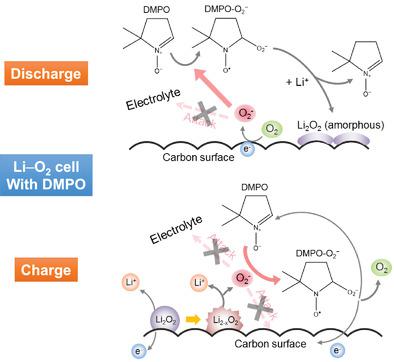当前位置:
X-MOL 学术
›
Adv. Energy Mater.
›
论文详情
Our official English website, www.x-mol.net, welcomes your
feedback! (Note: you will need to create a separate account there.)
Dual‐Functioning Molecular Carrier of Superoxide Radicals for Stable and Efficient Lithium–Oxygen Batteries
Advanced Energy Materials ( IF 24.4 ) Pub Date : 2020-09-22 , DOI: 10.1002/aenm.201904187 Youngjoon Bae 1, 2 , Hyelynn Song 3 , Hyeokjun Park 1 , Hee‐Dae Lim 4 , Hyuk Jae Kwon 2 , Youngmin Ko 1 , Chi Huynh 5 , Raquel Ovalle‐Robles 5 , Yong Hyup Kim 3 , Dongmin Im 2 , Kisuk Kang 1, 6, 7
Advanced Energy Materials ( IF 24.4 ) Pub Date : 2020-09-22 , DOI: 10.1002/aenm.201904187 Youngjoon Bae 1, 2 , Hyelynn Song 3 , Hyeokjun Park 1 , Hee‐Dae Lim 4 , Hyuk Jae Kwon 2 , Youngmin Ko 1 , Chi Huynh 5 , Raquel Ovalle‐Robles 5 , Yong Hyup Kim 3 , Dongmin Im 2 , Kisuk Kang 1, 6, 7
Affiliation

|
Low round‐trip efficiency and poor cycle stability remain the major challenges associated with lithium–oxygen (Li–O2) batteries. These issues are primarily triggered by or correlated to the radical species produced during the operation of Li–O2 cells, which lead to significant deterioration of the electrolytes and air electrodes. Regulation of the reactivity of these radical species would thus open up opportunities to suppress such side reactions. Herein, a dual‐functioning molecule that is capable of mitigating the reactivity of radical species produced in a Li–O2 cell by reversibly forming stable intermediate complex during both the discharge and charge processes is introduced. Specifically, 5,5‐dimethyl‐1‐pyrroline N‐oxide (DMPO) is exploited, which has been widely used as a chemical agent to detect oxygen radicals, to induce the reversible formation of an intermediate complex, DMPO–O2−, in the presence of superoxide radicals. It is demonstrated that DMPO mediates the O2−‐involved electrochemical reaction, leading to significant suppression of side reactions and a remarkably improved oxygen efficiency. Unexpectedly, it is also observed that upon charging, DMPO actively scavenges the superoxides from the surface of discharge products, thus substantially lowering the charging overpotential. The combined radical mediation and scavenging of superoxides result in cycle stability of a practical Li–O2 cell over 200 cycles with a specific capacity of 1000 mAh g−1. The findings indicate the importance of controlling the reactivity of radical species and suggest a new pathway toward the realization of stable and efficient Li–O2 batteries.
中文翻译:

稳定高效的锂氧电池超氧化物基双功能分子载体
往返效率低和循环稳定性差仍然是锂氧(Li-O 2)电池面临的主要挑战。这些问题主要是由Li-O 2电池运行过程中产生的自由基物质触发或与之相关,这些自由基物质导致电解质和空气电极的显着劣化。因此,调节这些自由基的反应性将为抑制此类副反应提供机会。此处,是一种双功能分子,能够减轻Li–O 2中产生的自由基的反应性通过在放电和充电过程中可逆地形成稳定的中间体配合物来引入电池。具体而言,5,5-二甲基-1-吡咯啉-N-氧化物(DMPO)被利用,这已被广泛用作化学试剂来检测氧自由基,以诱导中间复杂,DMPO-O的可逆形成2 - ,在超氧化物自由基的存在下。据证实,DMPO介导Ø 2 -涉及电化学反应,可显着抑制副反应并显着提高氧气效率。出乎意料的是,还观察到,在充电时,DMPO主动清除放电产物表面的超氧化物,从而显着降低了充电超电势。自由基介导和超氧化物清除的结合导致了实际的Li-O 2电池在200次循环中的循环稳定性,其比容量为1000 mAh g -1。这些发现表明了控制自由基物种反应性的重要性,并为实现稳定高效的Li-O 2电池提供了一条新途径。
更新日期:2020-10-28
中文翻译:

稳定高效的锂氧电池超氧化物基双功能分子载体
往返效率低和循环稳定性差仍然是锂氧(Li-O 2)电池面临的主要挑战。这些问题主要是由Li-O 2电池运行过程中产生的自由基物质触发或与之相关,这些自由基物质导致电解质和空气电极的显着劣化。因此,调节这些自由基的反应性将为抑制此类副反应提供机会。此处,是一种双功能分子,能够减轻Li–O 2中产生的自由基的反应性通过在放电和充电过程中可逆地形成稳定的中间体配合物来引入电池。具体而言,5,5-二甲基-1-吡咯啉-N-氧化物(DMPO)被利用,这已被广泛用作化学试剂来检测氧自由基,以诱导中间复杂,DMPO-O的可逆形成2 - ,在超氧化物自由基的存在下。据证实,DMPO介导Ø 2 -涉及电化学反应,可显着抑制副反应并显着提高氧气效率。出乎意料的是,还观察到,在充电时,DMPO主动清除放电产物表面的超氧化物,从而显着降低了充电超电势。自由基介导和超氧化物清除的结合导致了实际的Li-O 2电池在200次循环中的循环稳定性,其比容量为1000 mAh g -1。这些发现表明了控制自由基物种反应性的重要性,并为实现稳定高效的Li-O 2电池提供了一条新途径。











































 京公网安备 11010802027423号
京公网安备 11010802027423号